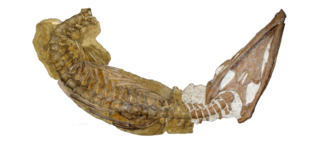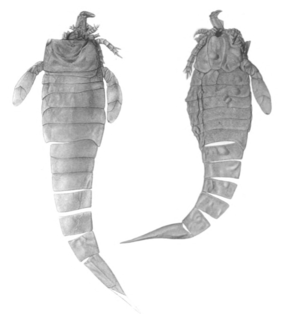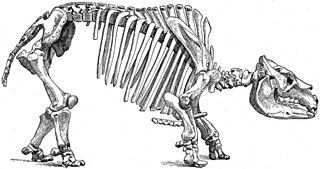 W
WBatrachosuchus is a genus of temnospondyl amphibian that existed from the Early to Middle Triassic of Southern Africa and the Blina Shale of Australia.
 W
WBrachauchenius is an extinct genus of pliosaurid that lived in North America during the Late Cretaceous.
 W
WBrachiosaurus is a genus of sauropod dinosaur that lived in North America during the Late Jurassic, about 154–153 million years ago. It was first described by American paleontologist Elmer S. Riggs in 1903 from fossils found in the Colorado River valley in western Colorado, United States. Riggs named the dinosaur Brachiosaurus altithorax; the generic name is Greek for "arm lizard", in reference to its proportionately long arms, and the specific name means "deep chest". Brachiosaurus is estimated to have been between 18 and 21 meters long; weight estimates range from 28.3 to 58 metric tons. It had a disproportionately long neck, small skull, and large overall size, all of which are typical for sauropods. Atypically, Brachiosaurus had longer forelimbs than hindlimbs, which resulted in a steeply inclined trunk, and a proportionally shorter tail.
 W
WDiceratosaurus is an extinct genus of nectridean lepospondyl within the family Keraterpetontidae. Fossils of Diceratosaurus were first described by Edward Drinker Cope in 1874. The species D. brevirostris is well known from Jefferson County, Ohio, with approximately 50 specimens having been collected from the Ohio Diamond Coal Mine. The mine was situated in the village of Linton, which became obscure soon after operations were completed and the mine closed in 1921.
 W
WGlyptotherium is an extinct genus of glyptodont, a group of extinct mammals related to the armadillos living from the Middle to Late Pleistocene, approximately 1.8 million to 12,000 years ago (AEO). The genus is considered an example of North American megafauna, of which most have become extinct. Glyptotherium may have been wiped out by changing climate or human interference.
 W
WHelodermoides is an extinct genus of anguid lizards from the Oligocene of North America. The genus is monotypic, including only the species Helodermoides tuberculatus. Helodermoides belongs to an extinct subfamily of anguids called Glyptosaurinae. In addition to many fragmentary bones, several complete skeletons of Helodermoides are known. Like other glyptosaurines, Helodermoides was covered in small scale-like bones called osteoderms. The osteoderms covering its skull are hexagonal, tightly interlocking, raised, and rounded.
 W
WHughmilleria is a genus of eurypterid, an extinct group of aquatic arthropods. Fossils of Hughmilleria have been discovered in deposits of the Silurian age in China and the United States. Classified as part of the basal family Hughmilleriidae, the genus contains three species, H. shawangunk from the eastern United States, H. socialis from Pittsford, New York, and H. wangi from Hunan, China. The genus is named in honor of the Scottish geologist Hugh Miller.
 W
WHypogeomys australis is an extinct rodent from central and southeastern Madagascar. First described in 1903, it is larger than its close relative, the living Hypogeomys antimena, which occurs further west, but otherwise similar. Average length of the femur is 72.1 mm, compared to 63.8 mm in H. antimena. One of the few extinct rodents of Madagascar, it survived to at least around 1536 BP based on radiocarbon dating. Little is known of its ecology, but it may have lived in burrows like its living relative and eaten some arid-adapted plants.
 W
WLycosuchus is an extinct genus of carnivorous therocephalians which lived in the Middle Permian 265—260 Ma existing for approximately 5 million years . It was a medium-sized predator, reaching 1.2 m (3.8 ft) in length with a skull 23 cm long.
 W
WMantelliceras is an extinct ammonoid cephalopod genus belonging to the family Acanthoceratidae and type for the Mantelliceratinae, that lived from the Late Albian to the late Cenomanian stage of the Late Cretaceous.
 W
WMegalohyrax is an extinct hyrax-grouped genus of herbivorous mammal from the Lower Oligocene, about 33–30 million years ago. Its fossils have been found in Africa and in Asia Minor.
 W
WNeohipparion is an extinct genus of equid, from the Neogene of North America and Central America.
 W
WNotoungulata is an extinct order of mammalian ungulates that inhabited South America during the Paleocene to the Holocene, living from approximately 57 Ma to 11,000 years ago. Notoungulates were morphologically diverse, with forms resembling animals as disparate as rabbits and rhinoceroses. Notoungula were the dominant group of ungulates in South America during the Paleogene and early Neogene. Their diversity declined during the Late Neogene, with only the large toxodontids persisting until the end of the Pleistocene. Several groups of Notoungulates separately evolved ever growing teeth like rodents and lagomorphs, a distinction among ungulates only shared with Elasmotherium.
 W
WOrnitholestes is a small theropod dinosaur of the late Jurassic of Western Laurasia.
 W
WPachyosteus bulla is a medium-sized selenosteid arthrodire placoderm known from the Upper Frasnian Kellwasserkalk facies of Late Devonian Bad Wildungen, Germany and from the Famennian portions of the Holy Cross Mountains of Poland. P. bulla has a broad skull about 7 to 10 centimetres long, a comparatively long median dorsal plate, and a short rostral plate that meets the pineal plate. In his cladogram, Rücklin (2011) regards P. bulla as a basal selenosteid, being the sister taxon of the American genera, and the Kellwasserkalk genera of Germany and Morocco.
 W
WPaliguana is an extinct genus of lizard-like lepidosauromorph reptile from the Late Permian or Early Triassic Katberg Formation in the upper Lystrosaurus Assemblage Zone of South Africa.
 W
WParamylodon is an extinct genus of ground sloth of the family Mylodontidae endemic to North America during the Pliocene through Pleistocene epochs, living from around ~4.9 Mya–11,000 years ago. It is also known as Harlan's ground sloth.
 W
WProterosuchus is an extinct genus of archosauriform reptiles that lived during the Early Triassic. It contains three valid species: the type species P. fergusi and the referred species P. alexanderi and P. goweri. All three species lived in what is now South Africa. The genus was named in 1903 by the South African paleontologist Robert Broom. The well-known genus Chasmatosaurus is a junior synonym of Proterosuchus.
 W
WScylacosaurus is an extinct genus of therocephalian therapsids.
 W
WScymnosaurus is now considered a nomen dubium.
 W
WSmilodectes is a genus of adapiform primate that lived in North America during the middle Eocene. It possesses a post-orbital bar and grasping thumbs and toes. Smilodectes has a small cranium size and the foramen magnum was located at the back of the skull, on the occipital bone.
 W
WSynapsids are a group of animals that includes mammals and every animal more closely related to mammals than to the other members of the amniote clade, such as reptiles and birds. They are easily separated from other amniotes by having a temporal fenestra, an opening low in the skull roof behind each eye, leaving a bony arch beneath each; this accounts for their name. Primitive synapsids are usually called pelycosaurs or pelycosaur-grade synapsids. This informal term consists of all synapsids that are not therapsids, a monophyletic, more advanced, mammal-like group. The non-mammalian synapsids were described as mammal-like reptiles in classical systematics, but this misleading terminology is no longer in use as synapsids as a whole are no longer considered reptiles. They are now more correctly referred to as stem mammals or proto-mammals. Synapsids evolved from basal amniotes and are one of the two major groups of amniotes, the other being the sauropsids, the group that includes reptiles and birds. The distinctive temporal fenestra developed in the ancestral synapsid about 312 million years ago, during the Late Carboniferous period.
 W
WTelmatosaurus is a genus of basal hadrosaurid dinosaur from the Late Cretaceous. It was a relatively small hadrosaur, approximately five meters (16 ft) long, found in what is now Romania.